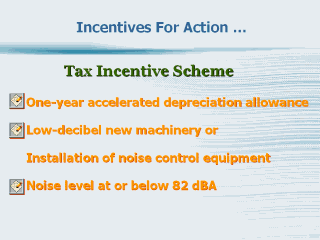| front |1 |2 |3 |4 |5 |6 |7 |8 |9 |10 |11 |12 |13 |14 |15 |16 |17 |18 |19 |review |
 |
Many of the NID
cases could have been prevented if effective measures were taken to prevent
or control the noise hazard. Proven technology and engineering controls
provide the most effective solutions to the elimination or reduction of
noise hazards. However, the cost of implementing such measures can be
significant, particularly for small and medium enterprises. To encourage
companies in implementing noise control measures, recognition and incentive
schemes have been established. Tax Incentive Scheme A Tax Incentive Scheme for Noise Control was introduced with effect from Year of Assessment 1999. The objective of the scheme is to help factories partially defray the cost of implementing engineering measures to control noise. A similar scheme has also been introduced for control of chemical hazard. The tax incentives mark an important milestone. For the first time, companies that invest in controlling occupational health hazards could expect financial assistance.Under the scheme, factory owners or occupiers can apply for a one-year accelerated depreciation allowance if they have, on or after 1 Jan 1998, purchased or installed equipment or technology for noise control that meet the prescribed criteria i.e. purchase of low-decibel new machinery, e.g. stamping machines and concrete crushers, or installation of noise control equipment such as acoustic enclosures and silencers. The noise level must be at or below 82 dBA which is 3 dBA lower than the current permissible exposure limit of 85 dBA. Thus, the scheme promotes the achievement of noise control standards that are better than what is required in the law. So far, a number of companies have taken advantage of the scheme, although the majority of companies have been able to implement effective noise control measures without relying on the scheme. Clearly, in most situations, the control measures were relatively inexpensive. |